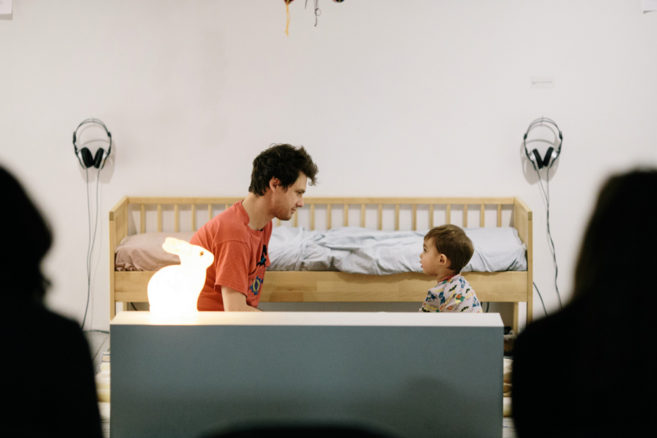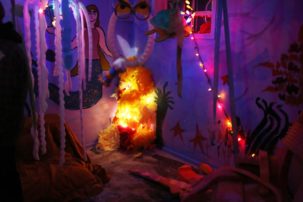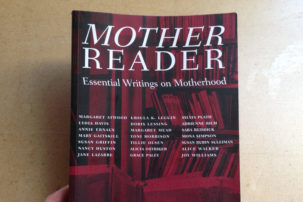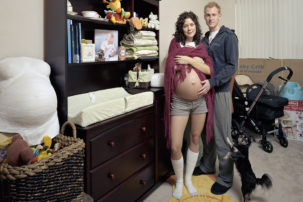If you walk into the Musée d’art de Joliette this month, you’ll see something rather unusual in the pristine white cube—a pile of sand, scattered with shovels and presented with the invitation to both young and old to cast plaster shapes in it. Now, you don’t have to be a scientist to know that sand is small and grippy, grainy and granular—it’s not easily self-contained, and not easily framed. It sticks, it strips, it embeds and spreads itself into everything.
In short, sand in the white cube is a mess—or a mess waiting to happen. But in the hands of Montreal art duo Leisure, this mess is very welcome. It’s a mess that not only evokes the lively, lived-in, laundry-piled studio of Barbara Hepworth, a photo-montage of which hangs behind the sand pile; this mess, or this mesh, perhaps, also conjures the way that creative influences and connections seep and shift, spear and spill.
Since they started working together as Leisure in 2004, artists Meredith Carruthers and Susannah Wesley have paid close attention to issues of relationality, influence, engagement, creation and connection—particularly in regard to the history of women artists in the 20th century, some of them sorely overlooked. This attention only grew sharper after Carruthers and Wesley each bore children, and started to surface the work of women artists whose practices were influenced by parenting and related care work—as well as related creativity theory. Here, they speak about those phenomena, as well as their first museum solo show on now in Joliette.
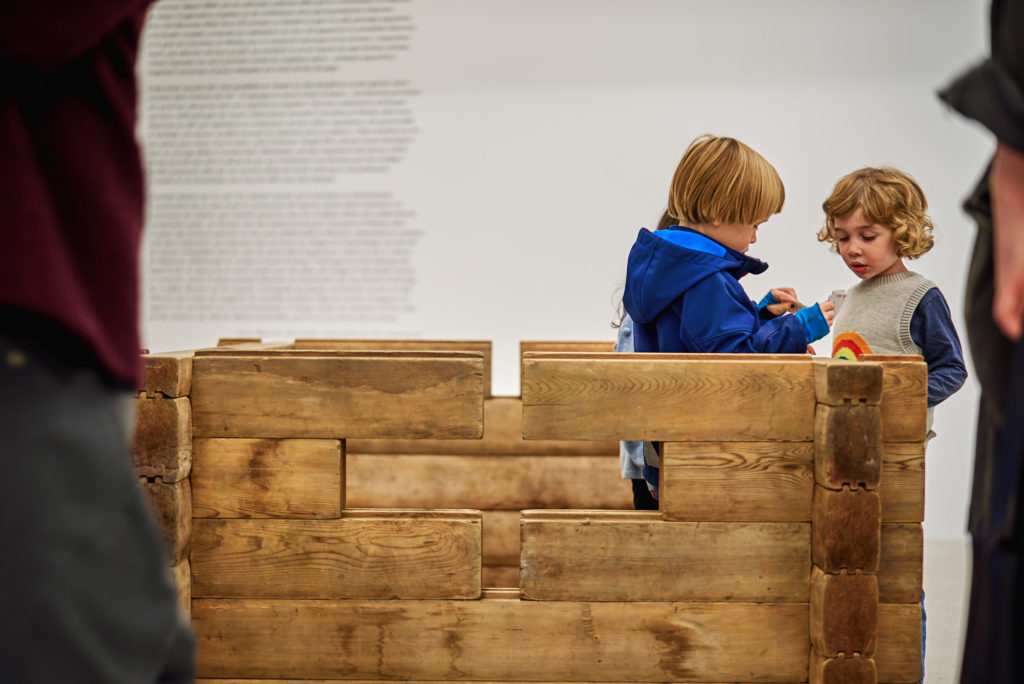
Children covene in Leisure’s installation Panning for Gold/Walking You Through It (2017) at Musée d’art de Joliette. The interactive sculptural piece is based on pieces of playground equipment that landscape architect Cornelia Hahn Oberlander designed for Expo 67. Photo: Romain Guilbault.

Sand, feathers and human touch are all part of Conversation with Magic Forms (2017) by Leisure. Here is a view from participation at Musée d’art de Joliette. Photo: Romain Guilbault.

Visitors at work on plaster casts and decoration in Leisure’s Conversation with Magic Forms (2017) at Musée d’art de Joliette. Photo: Romain Guilbault.

An installation view of Leisure’s Conversation with Magic Forms at Musée d’art de Joliette. The installation continues to change as visitors cast plaster in the sand. The photos behind are of Barbara Hepworth’s studio. Photo: Paul Litherland.
Q: Why is it important for you to make art with kids or other folks? Or in a way that welcomes in kids or other folks, whether art historically or otherwise?
A: A number of years ago, we came into contact with a text about the Theory of Loose Parts that was written by Simon Nicholson. And in that text, he talks about the experience of artwork in the gallery versus the experience of creative practice in the studio.
That essay made us think we needed to change the way we were working, to look at creativity more as a way of moving through space and transformation. We started looking at some questions: What is a studio practice? Who is involved in it? How can we bring that into the gallery space?
Nicholson is the son of Barbara Hepworth, so he would have had an experience of seeing art being made in studio and then put in a sterile, fixed way into a gallery. And Barbara Hepworth herself also wrote about how transformative having children was to her practice. It made her think about things in a much more abstract way. She moved into this cycle of work of creating forms that were representative of family units.
Barbara Hepworth described her studio as a different space than that of her neighbours. Mondrian had a studio next door which, you can imagine, was a very pristine space. And Hepworth’s studio was this complex space which had rocks and dirt and sand and laundry in and among the sculptures.
We found this really fascinating—this combination of artmaking and everyday life and work.
Q: One thing that I think is really surfaced in your practice, in and beyond kids specifically, is the way that knowledge is grown in a relational way. I feel your works point out that being and growing and making are inherently relational things.
A: Yes. We have worked collaboratively for many years, and in our research we have been interested in working in collaboration with other people and other histories. So thinking about how we open ourselves up to collaboration with our children, or other children, is just another iteration of that.
We have found that opening up our collaboration to more people pushes us to make different kinds of work—not that that’s always comfortable or easy. Even in a really amazing collaboration, you have to give up a certain amount of control in order to be receptive to new ideas. And that means there is less predictability in the outcome.
In one of the pieces in Joliette, visitors are invited to make sculptures, for instance—to do plaster casts from a sand pile. From this, there is an accumulation of smaller sculptures around a backdrop; the backdrop is a picture of Hepworth’s studio.
I feel like when you are a parent you need to learn that lesson in general of giving up control, and realizing that life is not going to be the kind of organized, compartmentalized thing that it was before you had kids. And I think we’re quite interested in that as a set of potentials rather than as a set of limits.
Doing an exhibition of our past work, it has been interesting to see the line of our own exploration and dialogue—one idea leading to another idea. We are also interested in communication that is nonverbal. For example, we have a piece that relates to a relationship between a painter named Gluck and a florist named Spry. That dialogue started through the arrangement of flowers.
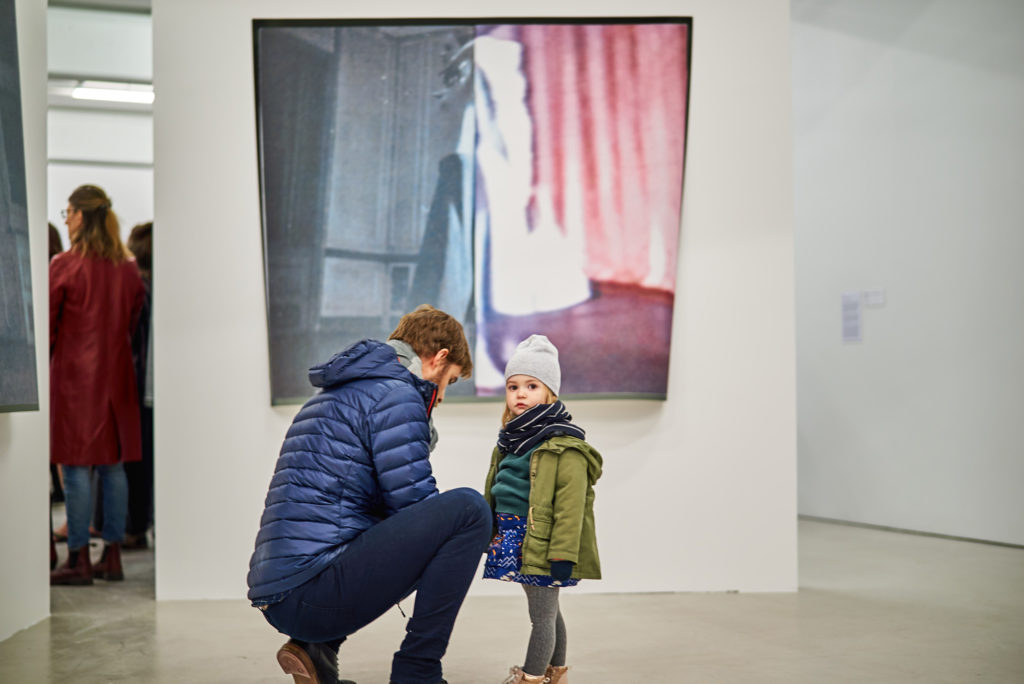
Visitors to Leisure’s exhibition “How One Becomes What One Is” at Musée d’art de Joliette in front of Dualité/Dualité (2015). Photo: Romain Guilbeault.

Leisure’s artwork Dualité/Dualité (2015) splices together imagery from different performances of Françoise Sullivan’s dance piece Dualité. It forms the centre of the Leisure solo exhibition at Musée d'art de Joliette. Photo: Romain Guilbault.

An installation view of Leisure’s exhibition “How One Becomes What One Is” at Musée d’art de Joliette. Photo: Paul Litherland.
Q: This is the first museum retrospective of your work. When did you begin your own dialogues or practice?
A: Our practice started in 2004. We were already working together for six years before one of us had kids.
Over the last few years, Anne-Marie St-Jean Aubre, contemporary art curator at the Musée d’art de Joliette, has been engaged in studio visits with us. She proposed the idea of bringing some pieces together there with the intention of making visible the links between our bodies of work.
The title of the exhibition, “How One Becomes What One Is,” is the title of a play by Lina Loos. For us, it’s about choices you make in your life and how that leads to a certain place.
Moving forward, we are continuing to work on a play by Lina Loos which is about her relationship with spaces created for her versus spaces created by her. When we were doing a residency in Vienna, we came across some of spaces designed by her husband, Adolf Loos—who is quite well-known for the essay “Ornament and Crime.” If you study him, you will find this domestic space that he designed at the beginning of his relationship with Lina. In art history, she is often treated as this footnote, but she was a writer in her own right, and this play unfolds in part in a space that looked very much like the room attributed to Adolf.
Q: So the title of your show borrows from someone else’s work, Loos’s specifically, emphasizing connectedness and overlap. How does that play out in the rest of the show?
A: In the exhibition, we tried to pay attention to the path that you take through the gallery, and the different overlaps between the works. To us, this speaks to a relational approach to history, and the idea that every point of view brings something different to a narrative.
We started to think about the whole exhibition almost as a landscape. Only one work really has a figure in it, so we decided to position this figure in the centre of this space. That work at the centre of the exhibition is based on the Françoise Sullivan performance piece Dualité. We installed it as a spinning figure, but also as a gap that you can see through.
We were interested in how Sullivan performed Dualité in 1948 as a young woman and then how it was performed later by other people. It’s especially interesting to think about when her original piece was about the duality of two minds in one body and the articulation of space between two bodies in dance.
There have also been some temporary events in the program. On November 11, we remounted a project called A Controlled Spill. We wove together big pieces of paper on the floor and gave kids bottles of food-based dyes to pour and spray. We originally did it at the Agnes Etherington Art Centre in 2017, with about six kids. This month, we had 30 participants. Then we hung the dyed sheets of paper in the glass atrium of the museum for a week. Given the location of the museum, we noticed a lot of adults and kids walking by the museum on a regular basis, so a lot of folks saw it on their trek to and from school.
Q: Your practice has often highlighted, in particular, the work of women artists historically—Sullivan, Hepworth, Loos and others. Why is that?
A: I think looking at women’s practices, particularly historically, it was much harder for women to be artists—to balance professional demands with expectations of the time. They had to make a lot of compromises, like moving away from the disciplines they wanted to do to work in, and instead work collaboratively with other women, or work more with design than with art, or do things based more in their homes or with their children.
In some of our works, we look at architect Cornelia Hahn Oberlander, for example. She graduated from Harvard in 1947, as a member of the first graduating class of women in landscape architecture. Later, with a family and the many expectations that entailed in the 1950s, she needed to find a different kind of way to have a practice, so she started designing progressive playgrounds inspired by watching her children play. And she enabled her children to test out her designs as they were being made.
We like looking at this kind of practice that didn’t get a lot of attention at the time but later can be recognized as quite important. And it’s not that we feel those practices were compromised—we feel it reveals a whole new sense of potentials. Something new comes out of it that couldn’t come out in its own time, but could reach a new public now with a different set of constraints, and changing family roles.
Q: What are the challenges of doing this kind of work—inviting children’s participation and creation in the gallery, for instance?
A: Well, just on the practical level there is an element of risk for museums and galleries to have projects with loose parts—artworks that are meant to be touched and related to in a more spontaneous and physically engaged way. If a museum or gallery doesn’t have staff watching all the time, they may not want to have that work activated.
The work we have done about Barbara Hepworth and Simon Nicholson has, basically, a sandbox as a big part of it. A sandbox where people—children or anyone else—can come and pour plaster of Paris in the sand and make a sculpture. And even having sand in a gallery, for instance, is a risk.
Now, in some artist-run spaces, it doesn’t matter—they’ll let people figure it out on their own. But in a more museum-type space, they can’t have that happening unsupervised, especially when they have collections and other things in the museum that could get damaged.
But at the same time, that’s what we are interested in pushing a little—and that’s what Simon Nicholson is interested in pushing: to make a gallery space, not always, but sometimes, engage with this kind of tension. A gallery space can provide a space potentially, of contemplation, but it can also be a space of activity.
Doing this kind of practice also means that when we install things there is more interaction with the infrastructures of the museum on every level. We get to meet with education teams and think about how things will be animated. We meet with the guards and with the people who do tours, so they are comfortable with the manipulation of objects.
Another interesting aspect of all this is the role of the artist itself. Because we are a duo, we operate under our own names and also under this collective name. And now, as we involve more people, it’s interesting to think: Who is making this work? And what does that mean?
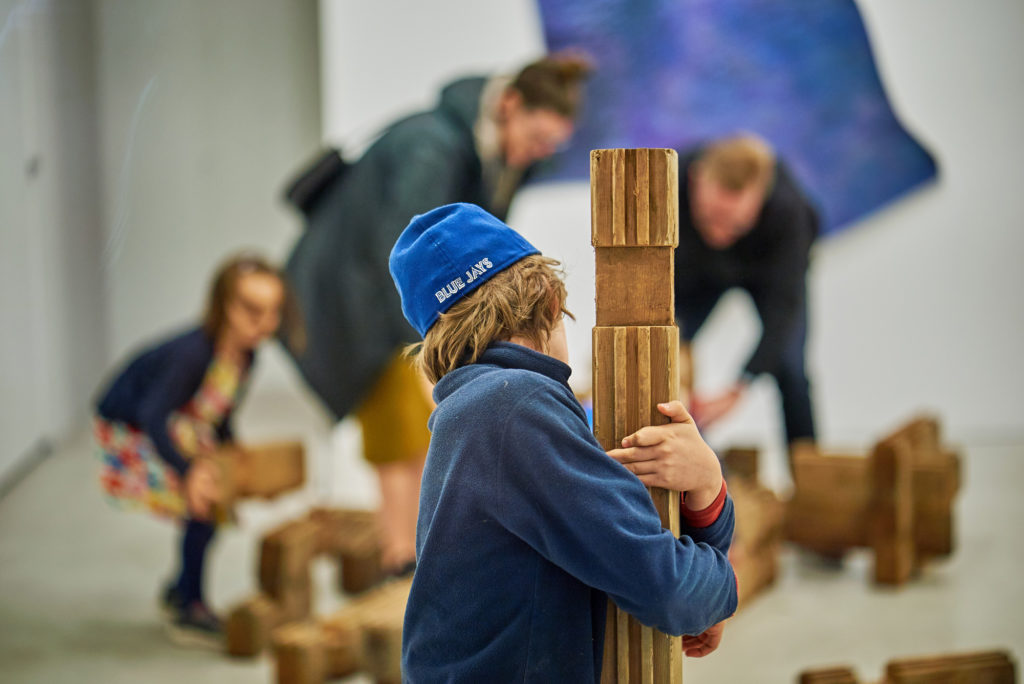
Leisure’s installation Panning for Gold/Walking You Through It (2017) has sculpted wood elements based on the playground equipment Cornelia Hahn Oberlander created for Expo 67. Visitors to Musée d'art de Joliette are welcome to build and rebuild with these pieces during the exhibition. Photo: Romain Guilbault.

Collaboration is a key part of Leisure’s practice, a fact highlighted in a video piece at the entrance of the duo’s exhibition at Musée d’art de Joliette. Photo: Paul Litherland.

Another work by Leisure in the collective’s solo show “How One Becomes What One Is” at Musée d’art de Joliette. Photo: Paul Litherland.

A sand pile with glitter, shovels, pipe cleaners and plaster is part of Leisure’s participatory installation Conversation with Magic Forms (2017) at Musée d’art de Joliette. Photo: Romain Guilbault.
Q: In the past couple of years it seems there has been an upswell in some art and exhibitions or projects around parenting, children, relationality and care. You’ve been involved in a few of these, like “The Let Down Reflex” in New York and Kingston, curated by Amber Berson and Juliana Driever. Do you agree there is a swifter movement here now, or is it just about where you look?
A: Actually, we’re also in a show in Edmonton at the moment dealing with politics and aesthetics around children—it’s called “Childish,” curated by Carolyn Jervis at John and Maggie Mitchell Art Gallery until December 8. I would say we have seen a change in the last two years. Even at openings I’ve noticed in Montreal, if they are in the afternoon, there are more places for children to go and colour or do an activity.
A lot of the explorations we have done came about because we were looking for role models in our own generation of artists and in the generation above us [around parenting and kids], and we weren’t really finding them. We were trying to figure how to grapple, in our own collaboration, with this big life-changing set of events around having kids. So some of it was pushed by that. And the fact that it seems to now be taken up in all different ways by different people makes it feel like there is some sort of change afoot.
We have spoken to a lot of female artists older than us who felt the chance to do reproductive work would not be compatible with the risk they needed to take as a studio artist. And, that time of bearing a child and losing control of your own mind and own body does something, for sure. If you need to rely on yourself in a studio practice, that it is a real choice, and a real concern. But we feel like we are seeing more younger families get involved, and that is a big change. So are the changing dynamics between people in family units.
Right now, we are involved with Optica, which has an artists-in-the-schools program. We are also working with DHC/ART on a project for school groups related to their Jasmina Cibic exhibition. The project will also be available to adults for Nuit Blanche. It’s great to see increasing interest in looking at what education can offer art, rather than just offer to art pedagogy.
The truth is, working with children is sometimes seen as not very interesting, or kind of second-tier. But it can be quite stimulating on different levels. If you take this seriously, there is quite a lot to learn and to research, conceptually, sociologically, and otherwise.
This interview has been edited and condensed. Leisure’s first museum solo show, “How One Becomes What One Is,” continues at Musée d’art de Joliette until January 6.

 A view of visitors at work on Leisure’s Conversation with Magic Forms (2017) at Musée d’art de Joliette. Photo: Romain Guilbault.
A view of visitors at work on Leisure’s Conversation with Magic Forms (2017) at Musée d’art de Joliette. Photo: Romain Guilbault.
